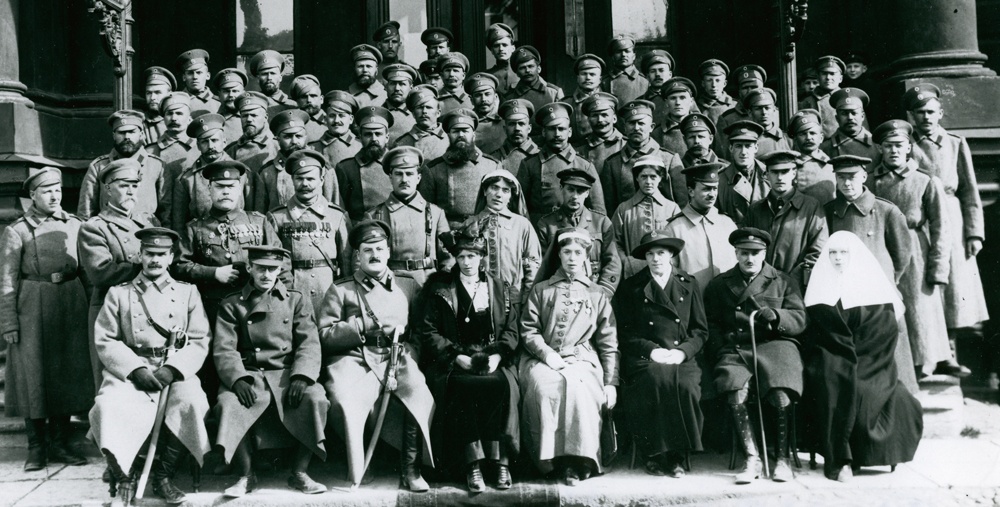This Month in History - Lady Sybil Grey

For the first in a series commemorating World War I and its impact on the region, we look at the inspirational Lady Sybil Grey who transformed Howick Hall in Northumberland into a wartime hospital, then travelled across Europe to help soldiers in need
Sybil volunteered as an Assistant Nurse as part of the British Red Cross and Order of St John of Jerusalem’s Voluntary Aid Detachment (VAD). This was a reasonably common wartime occupation for well-heeled women (other women who became VAD nurses during the war include Agatha Christie and Amelia Earhart). However, Sybil took to it with particular panache; she was soon running a hospital in her own home. Howick Hall opened as a hospital in October 1914, with activity centered on a makeshift ward in the ballroom. Here, over 400 patients were cared for by Sybil, her family, and members of the local community.
It seems to have been a happy environment – one patient suffering from a chest wound struck up a romance with, and later married, his nurse. On Christmas Eve in 1915, the family pushed the beds against the wall in the ward and held a dance for the soldiers, distributing Christmas stockings and raising a toast at dinner to Lady Sybil. But she was not there to celebrate with them. Sybil had been absent from Howick since October, having sailed across Arctic waters to Petrograd to set up a new Anglo-Russian hospital in the vast Dmitri Palace.
A huge, Neo-Baroque building by the Fontanka River with a distinctive orange facade and opulent interiors lit by brilliant chandeliers, the palace had hosted lavish parties for Russian high society in the 19th century, and had been home to the Grand Duke Sergei Alexandrovich before he was killed by a terrorist bomb. It was the property of Tsar Nicholas II’s cousin Dmitri Pavlovitch, one of the few Romanovs to later escape execution after the revolution. It took around three months to convert the space, and the Empress Alexandra herself opened the hospital in spring 1916. The juxtaposition between Romanov excess and the harrowing sights of a military hospital must have been stark.
Due to the location, the wounded were often coming from hundreds of miles away. As a result, Sybil decided to set off to the front to set up a Field Hospital, intending to bring her and her team closer to the action. Unfortunately, they got a little too close – while watching hand grenade practice in a small town near Minsk, some shrapnel hit Sybil in the face. She was rushed back to Petrograd for an operation.
Sybil returned to Britain to recover, but after only three months she was off again, visiting her brother Charlie in Paris before returning to Russia in October 1916. The country was one year away from the Bolshevik Revolution, and the situation was already sliding into chaos. Serious military incompetence had contributed to the rising unpopularity of the Tsar, who had unwisely taken personal charge of the army. The assassination of the sinister and influential court mystic Rasputin in December, followed by a food crisis in early 1917, led to revolution in February. There was fighting in the streets, exacerbated by violent military repression. At one point a mob invaded the hospital.
Sybil returned home that year to visit her dying father, and the Petrograd hospital closed shortly afterwards when Russia pulled out of the war. But Sybil’s work was not done yet. She took charge of the hospital at her uncle’s residence in London, Dorchester House (later demolished to become the famous Dorchester Hotel). She then spent a year leading the Women’s Legion in France, supplying ambulance drivers to the British army.
Although it’s impossible to know her motivation, it is likely that Sybil felt personally connected to the war, given that her cousin Sir Edward Grey was Foreign Secretary, and her brother Charlie was serving at Flanders. Following her accident, her meeting in Paris with Charlie in 1916 may have inspired her to re-enter the fray. But whatever her cause, her work is a remarkable testament to the strength of patriotic feeling across all classes of society during the war – and a testament to the potential of one woman to make a difference.
Thanks to Avril Meakin of The Howick Heritage Group, and Simon Boyd, Lady Sybil’s grandson.






